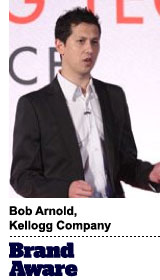 Welcome to “Brand Aware,” a column from the marketer’s point-of-view on the data-driven, digital ad ecosystem and written by Bob Arnold, Associate Director of Global Digital Strategy at Kellogg Company.
Welcome to “Brand Aware,” a column from the marketer’s point-of-view on the data-driven, digital ad ecosystem and written by Bob Arnold, Associate Director of Global Digital Strategy at Kellogg Company.
I’ve never worked in the publishing industry. I’ve been on the marketer side of the equation for my entire career, so I’ll be the first to admit I don’t know the ins and outs of what publishers do. I’m writing this column to share a marketer’s point of view on potential areas of opportunity that may exist for publishers to demonstrate value and points of differentiation within the programmatic space.
Many web publishers fear the programmatic space, and understandably so, since it’s a disruptive change to the legacy of the ad buy and selling model. They fear programmatic buying is simply a race to the bottom, but it doesn’t have to be that way.
I’m willing to pay for value. I know that like all advertising, there is a certain amount of waste in programmatic buying — I just don’t know where and how to exactly measure it. Frankly, that can lead marketers on a race to the bottom. If we don’t know how to value the inventory, then we are simply going to buy the cheapest CPM. The opportunity now is for publishers to clearly demonstrate the value they bring to the advertiser. The days of calling content “premium” just because there is a premium price are coming to an end.
Here are some ideas that could potentially be used by publishers to prove they are “premium.” Note, these thoughts are simply that — they still need to be tested and vetted.
Go beyond the in-view metric. One potential solution is to measure and quantify the value of something like “dwell time,” defined as how much time the consumer had a chance to see your marketing message. The assumption being the longer a consumer has to “dwell” on a page correlates to stronger branding metrics because there is a greater chance for the consumer to see and absorb the marketing message.
Go beyond “premium” placement. Contextual relevance in its strictest sense, while highly desired, is a bit of a misnomer for most marketers. Is the reach of contextually relevant placements large enough to support a billion dollar brand like Dawn dish soap? As much as the brand probably wants to be placed in only contextually relevant spaces, it’s not scalable. The next optimal step is to place ads where the content helps to support or even build upon the brand’s desired equity. The question is how do we easily understand when those opportunities occur, and when they do, how do we capitalize on it.
Go beyond third party data sources. This isn’t a knock on utilizing third party data sources by publishers to help advertisers target relevant consumers. They are powerful tools and should clearly be utilized. That said, a true differentiator for a publisher is understanding and aggregating your visitors in a way to that is useful for an advertiser. To be blunt, when a publisher has defined proprietary consumer segments, marketers don’t get excited since these proprietary consumer segments never line up to the brand’s strategic target. Publishers need to work closely with the advertiser to truly understand the marketer’s consumer insights and build targetable custom data sets.
If we can arrive at a point where these three elements become actionable within programmatic buying, publisher yields will rise, and frankly, marketers won’t be upset because they know that their buys are working even harder and resulting in increased ROIs.
Follow Bob Arnold (@bobbyarnold) and AdExchanger (@adexchanger) on Twitter.










